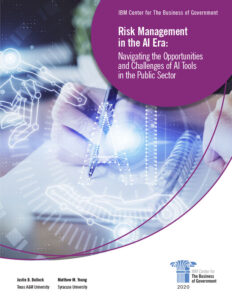Risk Management in the AI Era: Navigating the Opportunities and Challenges of AI Tools in the Public Sector
 Artificial Intelligence (AI) has moved into the mainstream of businesses and government.
Artificial Intelligence (AI) has moved into the mainstream of businesses and government.
Business leaders are rushing to take advantages of the benefits that can be brought to a wide array of industries to help increase productivity. Government leaders are also moving forward, but with appropriate caution. When considering the use and application of AI related technologies, government leaders weigh different factors than their private sector counterparts. Whether it is deploying self-driving electric trolleys in a city or retrofitting city streetlights with sensors to make them “smarter,” these leaders must address issues of accountability, transparency, ethics, equity, common good, effectiveness, efficiency, managerial capacity, and political legitimacy.
The report authors put forth a threefold strategy to assist government leaders and public managers with how best to approach using AI, which includes:
- reviews of prior federal government studies on the use and application of AI. These reports reflect a number of important issues for agencies and stakeholders to consider as they begin incorporating AI; the studies also highlight the government’s broad risk management approach to AI
- a risk management framework for when and how government can and should consider using AI tools, how to use these tools, and which organizational tasks and decisions may benefit from the use of AI
- case studies of two innovative uses of AI tools to help manage risks from local governments: the City of Syracuse, New York, and the City of Bryan, Texas.
The authors close with a list of practical guidelines for government action in using AI tools to improve the overall quality of governance, while incorporating similar tools into their overall risk management strategy.
2016: PBGC OIG ERM Framework
This memorandum is to document the establishment and implementation of an Enterprise Risk Management program at the PBGC Office of Inspector General. By adopting a portfolio view of risks, ERM will enable the OIG office to:
- lead by example,
- provide for more effective risk management and internal control in accordance with OMB Circular A‐123,
- align management activities with the CIGIE Quality Standards for Federal Offices of Inspector General (also known as the “Silver Book”),
- concentrate efforts towards key points of failure and reduce or eliminate the potential for disruptive events,
- allow for risk‐based planning, and
- protect the PBGC OIG brand (“independent, positive engagement”) and identify opportunities to create value.
The framework for this program is based on (the soon‐to‐be issued) OMB Circular A‐123, The Orange Book, Management of Risk – Principles and Concepts (October 2004, HM Treasury), and the Committee of Sponsoring Organizations of the Treadway Commission’s (COSO) Enterprise Risk Management Framework. This memorandum describes responsibilities and governance structure, the foundation of this program, the components of this program, the external and internal environment to provide necessary context for assessment of OIG risks, the methodology for developing our risk appetite, and the methodology for developing our risk profile.
Download
